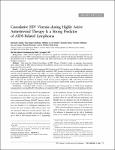Cumulative HIV Viremia during Highly Active Antiretroviral Therapy Is a Strong Predictorof AIDS‐Related Lymphoma
Zoufaly, Alexander
Stellbrink, Hans-Jürgen
Heiden, Matthias an der
Kollan, Christian
Hoffmann, Christian
Lunzen, Jan van
Hamouda, Osamah
Background.AIDS‐related lymphoma contributes to significant morbidity and mortality among human immunodeficiency virus (HIV)–infected patients receiving highly active antiretroviral therapy (HAART). We assessed the predictive role of cumulative HIV viremia and other risk factors in the development of AIDS‐related non‐Hodgkin lymphoma. Methods.Data from the Clinical Surveillance of HIV Disease (ClinSurv) study, an ongoing, observational, open cohort study of HIV‐infected patients from different urban areas in Germany, were analyzed using a Cox proportional hazards model. Results.In the Cox model, which comprised 6022 patients and 27,812 patient‐years of follow‐up while patients were receiving HAART from 1999 through 2006, cumulative HIV viremia was found to be independently associated with the risk of lymphoma (hazard ratio, [HR], 1.67 [95% confidence interval {CI}, 1.27–2.20]) (P < ,001 ). This association differed markedly between lymphoma subtypes. Although the association was more pronounced for Burkitt‐type lymphoma (HR, 3.45 [95% CI, 1.52–7.85]) ( P = ,003 ), there was no association between cumulative HIV viremia and the incidence of primary central nervous system lymphoma (HR, 1.00 [95% CI, 0.39–2.57]) (P = ,997 ). Other risk factors associated with an increased risk in a multivariable analysis included the latest CD4 T cell count as well as age per 10‐year increment. Conclusions.Cumulative HIV viremia is an independent and strong predictor of AIDS‐related lymphoma among patients receiving HAART. The influence of cumulative HIV viremia may differ between lymphoma subtypes.
Dateien zu dieser Publikation
Keine Lizenzangabe

